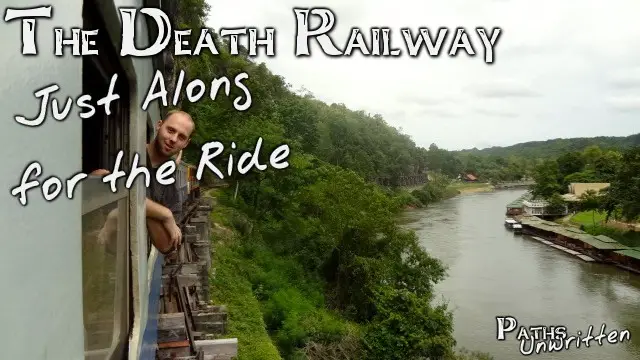
It was a legendary railroad, but a late start leaving everyone else behind in Kanchanaburi. The Thailand-Burma Railway, more commonly called the Death Railway because of the harsh conditions and prisoner/slave labor used to construct it, was a train track built to move Japanese troops and supplies from Bangkok to Yangon during their occupation of the region in World War 2. I could not seem to find out whether or not it was ever completed, though.
The 4:17 train I was waiting for didn’t arrive until and hour and a half later. I had no idea what to expect once I boarded, but it ended up being one of the most memorable things I’ve done in Thailand.
The train from Kanchanaburi begins by looping through the downtown area to cross the Bridge Over the River Kwae. We had gone to this bridge in December, but its architectural impressiveness didn’t quite live up to the historic lore behind it.
Within the next half hour, we were in flat grasslands with rising limestone silhouettes in the distance. Sometimes skirting the river and others far from it, the scenery was immensely varied and amazing. We passed several decommissioned, or maybe simply underused stops along the way, including many I had seen on my last trip here. However we finally came to someplace I recognized very well, the Wampo Viaduct.
The train cuts its speed down to nearly a quarter as it passed the oddly located Miracle of Life English camp and began its slow trek across the less-than-sturdy looking bridge. People leaned out of the riverside window in order to get a signature photo over the river bend
and floating resort rooms. I, however, was on the right side of the train, and had a lovely view of the cliff was and the cave Buddha of Tham Krasae when we came to it.
As busy as the next stop had been when I visited by motorbike, it was nearly empty now that it was nearing sundown, and only a few souls exchanged as the train again pulled away within a moment.
Not too far down the line from Wampo was something the stood out quite amazingly. Atop a mountain in the distance was an enormous and ornate temple of some sort. A Thai person tried to explain it to me, but all he could really get out was “nuns live there.” Unable to find any information or even a name for it, I finally set out to find it on my own nearly a year later.
It was well past dark when the train reached its final stop in the town of Namtok. All the restaurants near the train station had long since shut down and I’m quite certain I was the only foreigner in the area. Taking my small weekend bag in hand, I set way into the small, very empty town. And though a few incidents with stray dogs did shake my confidence a bit, I eventually made my way to the main road and found a pleasant room at the Bung Kalo Sai Yoke Noi.




















